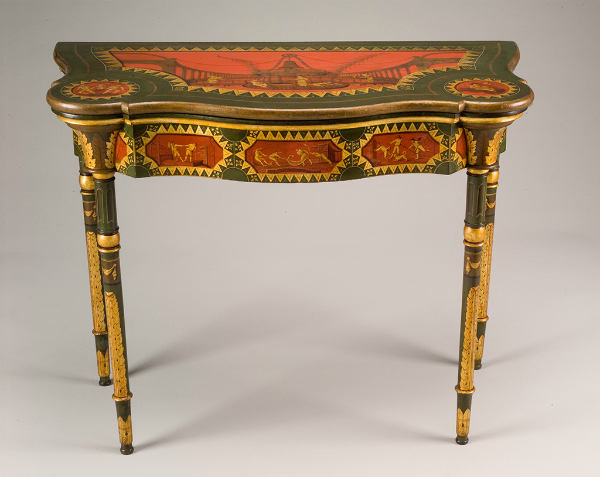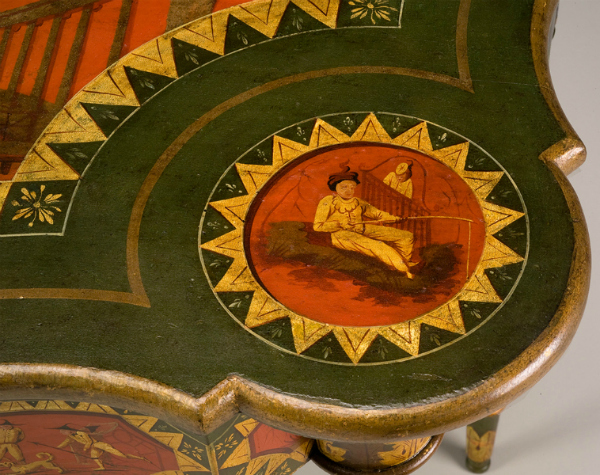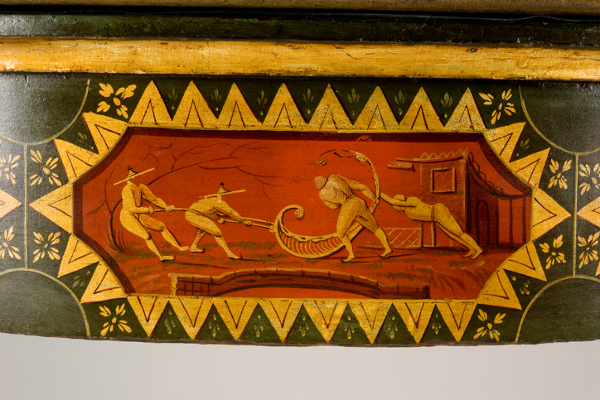Shop shop shop. Ship ship ship. I am not talking about CyberMonday here.
Rather, in a time of international economic turmoil I find comfort in recalling the "Old China Trade." It helped rejuvenate a flailing post-Revolutionary American economy after the British had closed the fledgling Republic out of markets across the Atlantic. Ever entrepreneurial, Americans began trading in Canton (now Guangzhou) following the voyage of the Empress of China, the first American merchant ship to reach the celestial kingdom -- in 1784. She returned to New York harbor in May 1785, laden with goods that brought her investors a clear profit of 20 percent or more. A truly enviable R.O.I. these days... Two months later, on August 12th, another ship -- crammed to the gunnels with Chinese wares -- anchored in Baltimore harbor. The local Maryland Journal exulted:
On Tuesday evening last, arrived here, direct from China, the East Indiaman Pallas commanded by her owner John O'Donnell. She has on board an extensive and valuable cargo consisting of a variety of teas, Chinese silks, satins, nankeens (durable yellow cloth), &c. We are extremely happy to find the commercial reputation of this town so far increased as to attract the attention of gentlemen who are engaged in carrying on this distant but beneficial trade.
The swashbuckling Irish-born O'Donnell (1749-1805) made so much money selling his cargo that he acquired in excess of 1900 acres on the waterfront east of Fells Point, married a local sea captain's daughter, and settled down (when not out on the bounding main) in an elaborate estate aptly christened "Canton." He counted George Washington -- determined to expand the China trade -- among his first acquaintances. Over the next two decades, O'Donnell was instrumental in transforming Baltimore into the third largest city in the United States.
O'Donnell's arrival was roughly coincident not only with new local patronage for high end consumer goods but also with publication of an influential tome in the canon of decorative art: the Cabinet-Maker and Upholsterer's Guide [London, 1788]. In it, George Hepplewhite observed:
a new and very elegant fashion has arisen within these years, of finishing [furniture] with painted or japanned work, giving a rich and splendid appearance to the minuter parts of the ornaments, which are generally thrown in by the painter.
Created at a time when Baltimore's fancy furniture was unequalled in the United States, our exuberant card table represents a collaboration between cabinetmaker and decorator -- in this case Thomas Renshaw, who transferred his furniture business from Washington to Baltimore early in the 19th century, and John Barnhart, who had started his Baltimore career as a sign painter by 1799. We know the two worked together briefly in 1814-1815, allowing us to date the table precisely. Clearly, by then Barnhart had moved up from advertising art -- the ornaments he "threw in" are late but ebullient expressions of Chinoiserie, a decorative style beloved in Europe since the late 1600s.
Festive as a red, green, and gold circus wagon, the table is decorated with scenes populated by figures in pantaloons and coolie hats. Such outfits were familiar in Baltimore after O'Donnell's arrival in the Pallas, when the Maryland Journal described "the crew of the ship, Chinese Malays, Japanese and Moors, with a few Europeans, all habited according to their different countries" as "no unpleasing sight." Among the painted decorations we find an armed coolie and barking dog chasing a fleeing pig-tailed miscreant, and a pendant scene where he's caught and punished. There is a precariously seated mandarin with parasol traveling by sedan chair, even an ornamental C-scroll being pushed and pulled by four straining figures as if it were a fanciful but extremely heavy skiff.
Barnhart's painted and gilded ornament may nod to the table's original owner -- John Donnell (1754-1827) -- yet another Baltimore shipping merchant with lucrative dealings in the Far East. Not to be confused with the aforementioned O'Donnell, this Baltimore entrepreneur rejoiced in his commercial success by acquiring and furnishing Willow Brook, a late 18th-century villa overlooking the Patapsco River west of the early city limits. (Maintaining our nautical theme, Donnell got the house when Thorowgood Smith, the mercantile trader who built Willow Brook, suffered severe financial reverses and went bankrupt before he could occupy the premises.) In those days you could see the water from Willow Brook, and the house served as a country retreat, as witness the image on the table top of a man seated on a bank leisurely fishing.
More recently the West Baltimore neighborhood where the villa once stood has been used to film episodes of The Wire, David Simon's serial police drama that captures a dark and brutal energy quite different from the entrepreneurial optimism of the city's founding elite. Back in the early 1800s, the table likely witnessed somewhat milder confrontations between the Red Queen and the White. Imported from China, the Donnell family's intricately carved ivory chess set, half of it stained carmine, also survives in the museum's collection, as does the parlor where the family and guests once played chess.
In Domestic Manners of the Americans (1832), Frances Trollope spat that the women of Baltimore, unlike their sisters in Philadelphia, dressed with "gaudy splendor." The same can be said of Baltimore's painted furniture. The sheer flamboyance of ornaments "thrown in" by Barnhart and other artisans gave Baltimore cabinetmakers an edge over competitors making painted furniture up and down the Eastern seaboard at the turn of the 19th century. No use being timid. Ask Mrs. Simpson.



Card Table
Baltimore, c. 1815
Maker: Thomas S. Renshaw (active in Baltimore 1810-1816)
Painter: John Barnhart (active in Baltimore 1814-1829)
Wood with polychrome and gilt decoration
29 ¾ x 36 ¾ x 18 ¼ inches
The Baltimore Museum of Art: Friends of the American Wing Fund, Middendorf Foundation Fund, and Charlotte B. Filbert Bequest Fund; and purchase with exchange funds from Bequest of Margaret D. Morriss, BMA 1998.61